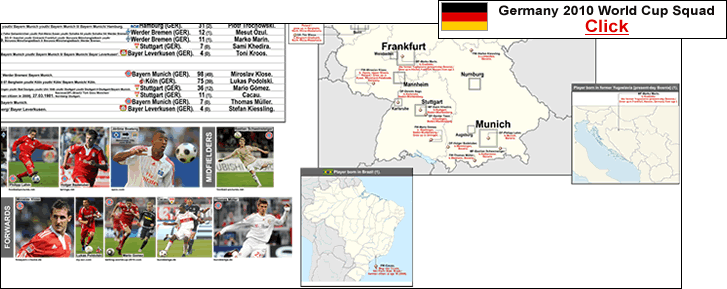
Germany 2010 World Cup squad.
The map shows the birthplaces and hometowns of the players on the Germany national team that is competing in the 2010 World Cup in South Africa. At the bottom, left of the map page are photos of all the players in the German squad who have seen action in the first 5 matches in the competition (19 player photos). International appearances (aka caps) and international goals as of 3rd July, 2020 are listed.
-
From The Telegraph.co.uk, by Duncan White, Mesut Ozil at head of the vanguard for new generation (12 June, 2010).
These days, Germany fields an ethnically diverse squad. There are 5 players on the Germany squad who were born abroad. Three players were born in Soviet bloc-era Poland: starters Miroslav Klose and Lukas Podolski (both of Silesian heritage), and sub Piotr Trochowski. One player, midfielder Marko Marin, is a Bosnian Serb whose family fled war-torn Bosnia for Germany in 1991. One player, Cacau, is Brazilian-born and raised. He became a German citizen in 2009. While on the subject of players from abroad, it is worth mentioning that midfield wizard Mesut Özil is a third generation Turkish German. DF Serdar Tasci is also of Turkish origin. Starting midfielder Sami Khedira is a Tunisian-German. DF Jérôme Boateng is of Ghanian-German descent. And DF Dennis Aogo is of partly Nigerian descent.
-
Thanks to the contributors to the pages at en.wikipedia.org, Germany national football team. Thanks to UK Soccer Shop.com, for the photos of the Germany jerseys.
June 20, 2010
2010 FIFA World Cup: Germany, 23-man roster.
August 16, 2009
Germany: Clubs in the 2009-’10 Bundesliga season, with 08/09 attendance figures.
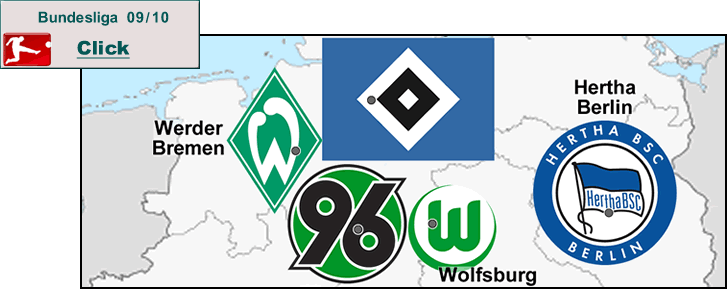
Bundesliga table {click here (SoccerStats)}.
Reigning champions are the tepidly supported dark horses VfL Wolfsburg, powered by the record-setting goal-scoring tandem of Edin Dzeko and Grafite {see this (VfLWolfsburg.de, 23 May, 2009, ‘Dzeko and Grafite- A record-breaking strike-force’)}. Their 54 goals eclipsed the 53 goals scored in 1971-’72 by Gerd Müller and Uli Hoeness, of Bayern Munich. Speaking of the Bavarian giants, their former manager, Felix Magath, led Wolfsburg to their unlikely first title. Magath had been sacked by Bayern Munich in January, 2007, when the club was in fourth place, and below Champions League qualification. That Magath had led Bayern Munich to two consecutive league and cup doubles (in 2004-’05 and 2005-’06) was not enough. So it must be rather satisfying for Magath to win the title with a club like Wolfsburg…essentially Volkswagen’s pet club, and a club that has never been on any list of big German clubs. In terms of German standards, Wolfsburg play in a small stadium (30,000 capacity) that has never been filled to capacity over a season. And again, speaking of the Bavarian giants, it was only fitting that the Bundesliga goal of the season, a Grafite back-heel after a mazy run, was scored by one of Magath’s players against his former club {see this (‘Grafite’s signature goal takes Wolfsburg’s winning sequence to eight’, by Raphael Honigstein at Guardian.co.uk)}. Magath has left Wolfsburg, after signing a fat contract with FC Schalke 04. So he has got a reward for his acumen as a manager, but he has his work cut out for him, seeing as how Schalke are a notoriously underachieving club.
-
The map is accompanied by an all-time titles chart of the German Bundesliga. The Fussball-Bundesliga began play for the 1963-’64 season. Prior to that, the national champion was determined by a play-off between clubs which had qualified through the many regional leagues. Semi-professional status was introduced in 1949, when five Obërligen (Premier Leagues) were in existence. The five leagues can be seen here.
For the list of national champions in Germany, 1903-Present , {click here (Wikipedia, List of German football champions)}. Here is the list by total titles {click here}.
-
I also have listed all the European qualifiers from Germany. Wednesday, 19 August, Stuttgart starts their two-legged draw versus FC Timisoara, of Romania, for qualification to the 2009-’10 Champions League Group Stage. Wolfsburg and Bayern Munich are already in the 09/10 Champions League Group Stage. Draws for Play-offs for CL Group Stage, {here (UEFA.com/ucl)}.
In the Europa League (the re-brandedf and re-formatted UEFA Cup), Hertha Berlin, Werder Bremen, and Hamburg are in contention. UEFA.com Europa League main page, here.
Thanks to http://www.bundesliga.de/en/ . Thanks to the contributors to the pages at Wikipedia {click here (set at Fussball-Bundesliga 2009-10 page)}. Thanks to Sascha Drenth @ Panoramio.com {click here}. Thanks to Christoph F. Siekermann at the German Wikipedia. Thanks to RP Online.de {click here}. Thanks to Soccerway {click here (set at ‘Edin Dzekov [sic] is going to stay at Wolfsburg’)}. Thanks to Subsidesports.com {click here}. Thanks to UKsoccerShop.com {click here}.
June 5, 2009
Germany: the 3 clubs promoted at the end of the 2008-’09 season, from 2.Fussball-Bundesliga to Fussball-Bundesliga.
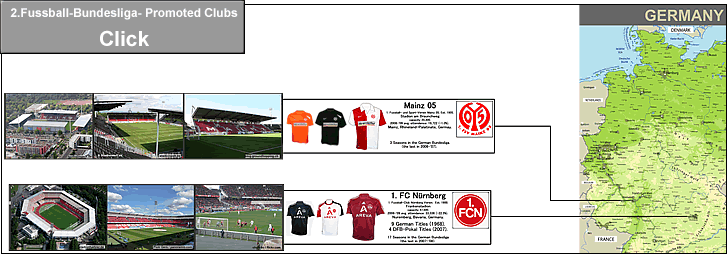
The map shows the three clubs to win promotion to the German Bundesliga-1 for the 2009-2010 season.
Bundesliga -2 winners in 08/09 were SC Freiburg, a yo-yo club from the foothills of the Black Forest, in far south-western Germany, in the state of Baden-Würtemburg. Freiburg has spent 10 seasons in the top tier in Germany, their last in 2005-’06.
Second in Bundesliga-2 were FSV Mainz 05, a club from Mainz, which is 32 kilometers (19 miles) west of Frankfurt, in the state of Rhineland-Palatinate. Mainz had never been in the first division before 2003-’04, and were relegated in ’07. Next season will be only the club’s fourth in Bundesliga-1.
The winner of the promotion/relegation playoff, over Energie Cottbus, was FC Nürnburg, a club with a storied past. Nürnburg won 6 German Titles in the era between the two World Wars; they won another national title in 1948, and they won one in 1961. Nurnburg has won one championship since the Bundesliga began in 1963-’64…in 1968. That is a total 9 German titles. Nürnburg has also won 4 DFB-Pokal [German Cup] Titles, their first two in the 1930′s, one in 1962, and their most recent in 2007. Nürnburg plays in the 47,000-capacity Frankenstadion, which was renovated for the 2006 FIFA World Cup. In their last season in Bundesliga-1 (07/08), Nürnburg drew 43,033 per game. Nürnburg bounces straight back to Bundesliga-1 for the 2009-2010 season, which will be the northern Bavarian club’s 18th season in the German top flight.
In a side note, with Energie Cottbus’ relegation, Bundesliga-1 will be without a club from the former East Germany for only the second season since German re-unification. East and West Germany were united in 1990, and for football clubs, the best two clubs from the 1990-’91 DDR-Oberliga season were accomadated to Bundesliga-1 for 1991-’92 {see this}. These were Hansa Rostock (who have now spent 12 seasons in Bundesliga-1) and Dynamo Dresden (who have now spent 4 seasons in Bundesliga-1). The other season with no former-East German club-representation was in 2005-’06…Hansa Rostock had been relegated in 04/05, and Energie Cottbus would gain promotion in the spring of ’06.
[Note: I didn't use a blank map for the base map on this post, because I found a nice map that showed German cities with their metropolitan areas. Here is a list of the largest cities/ urban areas, from the CityMayors site (they don't list year of population estimate, but it's probably 2003, like the list for France that I linked in my last Promotions map) {click here}.]
Thanks to the Maps of Germany site, for the base map {click here}. Thanks to Subside Sports, for kit photos {click here}. Thanks to FanSport24.d, for kit photos {click here}. Thanks to Jako.co.uk, for a generic white jersey for me to slap togather a rendition of the elusive 08/09 SC Freiburg away jersey {click here}. Thanks to http://www.colours-of-football.co.uk . Thanks to the contributors to the pages at Wikipedia {click here (set at Fussball-Bundesliga, 2009-2010 season)}. Thanks to Bobby McMahon {click here} for pointing out the no-East German clubs-for-the-second-time angle.
September 1, 2008
Germany: Clubs in the 2008-09 Bundesliga (with attendances from 07/08).
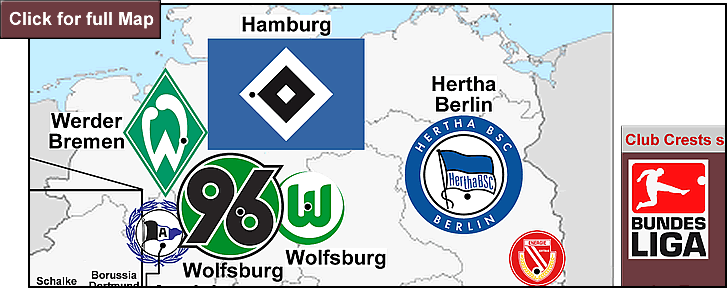
Germany, Bundesliga 2008-09 (with 2007-08 attendances)
…
Please note:
My latest Bundesliga map-&-post can be found here, category: Germany.]
…
Defending champions Bayern Munich look to consolidate their historical dominance of the German Bundesliga. The Bavarian giants have won 20 Bundesliga titles, out of a total of 44, since the league began, in 1963-’64. And they have been champions 7 of the last 10 seasons.
The club has just built a state of the art training ground to complement their space age stadium. The facility was built in just 6 weeks. It’s design had considerable input from new coach Jurgen Klinsman, and features the sort of new age accents (spare, Asian-inspired interiors, complete with Buddha statues) and hi-tech gadgetry (lockers featuring computerized consoles and message boards) that befits someone (Klinsman) who has spent some time in California recently. {See this article, from Der Speigel online.}
Here is an overview of the 07/08 season, and a 08/09 preview, from the “BetInf [dot] com” site: {Click here}.
{Click here, for the leading scorers in 07/08 (ESPN Soccernet)} .}
{Click here for the current Bundesliga table (from the Sky Sports site)}.
Thanks to European Football Statistics, for the attendance figures {Click here}.
Thanks to World Soccer, whose August issue gave me a topic here.
June 11, 2008
UEFA Euro 2008: Germany- Squad Map.

Though they were outshot by Poland 12-14, Germany won their first game last Sunday by a score of 2-0, with both goals scored by Polish-born Lukas Podolski {click here, for a report from the UEFA site}. Thursday, Germany plays Croatia.
There are three Polish-born players on the German team: Miroslav Klose, Lukas Podolski, and Piotr Trochowski. Both Klose and Podolski were born in Silesia {see this}, which was formerly part of Germany. Most of Silesia is now in (south-west) Poland, with sections in the Czech Republic, and Germany. {Click here, for background on Miroslav Klose’s family, and how they were able to get out of Communist-era Poland, with the help of German-ancestry laws.}
The map shows the 27 cities in Germany with a population over 250,000. Here is a list of the largest cities in Germany {mongabay site; click here}. Below is a population density map of Germany (from Wikipedia).
Thanks to the UEFA site {click here} for the German kits.
[Note: Players caps and goals are listed up to before the start of Euro 2008.]
April 27, 2008
Germany: Bundesliga, 2007-08 Season-Zoom Map.
…
…
[Note: to see my most recent map-&-post of Bundesliga, click on the the following, category: Germany.
On this map, in deference to the quite impressive attendance figures of the Bundesliga, I have included a column listing percentage of capacity, on the average attendances list. Those Germans really know how to pack ‘em in. Plus their stadia generally seem to be very fan-friendly, with almost zero ugly track-and-field ovals, good site lines, and seats right up on top of the action. And this being Germany, after all, I am quite sure that the beverages are top notch. Plus, I understand that the ticket prices are very reasonable. With all these incentives, fans flock to Bundesliga matches…ten clubs are averaging over 40,000 per game (and 3 clubs in Bundesliga-2: FC Koln, Borussia Monchengladbach, and 1860 Munich, are averaging over 37,000 per game).
This map shows all the German Tiltles, since 1903, although there was no unified pro football league in Germany until 1963-’64. That was when the Fussball-Bundesliga was formed.
Up until that point, football in post-war Germany was divided into 5 separate leagues, or Oberligen (meanwhile, Soviet-occupied East Germany had it’s own, corrupt, league). In West Germany, there were the North, South, West, Southwest, and Berlin Oberligen.
In 1962, the decision was made to consolidate, in emulation of the English Football League structure. 46 clubs applied for membership in the new, nationwide, top tier. 16 were selected, on basis of prior achievements {see this, from Wikipedia}. The Bundesliga began in the autumn of 1963.
Since then only one team has remained in the Bundesliga continuously: Hambuger SV (usually called Hamburg, in the English-speaking world, probably because no one wants to conjure up the image of a ground beef sandwich). But this club from that northern port city has not won the crown for 25 years running.
Since the Bundesliga’s formation, one club has stood out, in terms of success: FC Bayern Munchen (ie, Bayern Munich). Again, this season, the giant club from Bavaria will win the championship. It will be their 21st German Title, and, amazingly, their 20th Bundesliga crown. That will amount to 20 Bundesliga Titles, out of a total of 45 Bundesliga seasons. And their success now has a shining new monument (literally): the Allianz Arena {see this image; see this Wikipedia entry}. It has been sold out the entire season.
Thanks to http://www.colours-of-football.com. for the kits.
September 19, 2007
German Football-Bundesliga, Attendance map, 2006-07.
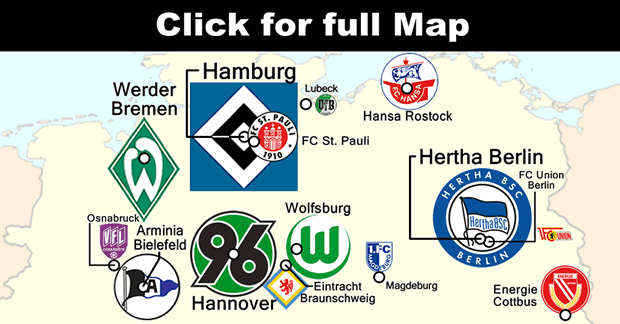
…
…
Note: to see my latest post on German football, click on the following, category: Germany.
…
German fans have it good. The Bundesliga is full of gleaming sports palaces, and ticket prices are reasonable. Last year’s World Cup brought a lot of stadium improvements. Ticket prices are low because the clubs really are clubs, and the aim is recreational enjoyment for its members more than it is for profit. Another nice thing is how close to the action the fans are. In stadiums like Schalke’s Veltins Arena, Dortmund’s Westfalenstadion, and Munich’s new Allianz Arena, the stands are extremely close, and at a high angle. It must be great for spectators. It sure looks great on TV, as opposed to say, the Italian league, where it seems to be mandatory to have an ugly track oval separating the fans from the action. I’m sorry, but is track and field that popular ? I mean Manchester City made sure that track oval was gone once the Commonwealth Games were over.
September 16, 2007
German Football-Bundesliga Map, 2003-2007.

…
…
Please note:
My latest Bundesliga map-&-post can be found here, category: Germany.]
…
I hand-drew this map in early 2004. I have updated it to spring 2007 by adding all the teams who have been promoted, from Bundesliga 2, since then. Thumbnail lists of the last four Bundesliga seasons (2003-04, 2004-05, 2005-06, 2006-07) are included.


